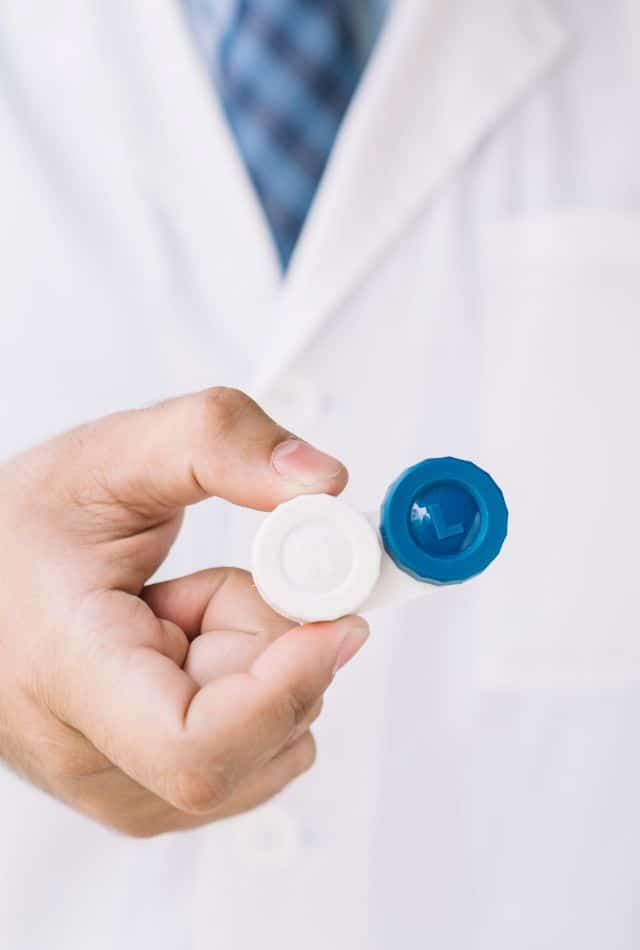How to Read Contact Prescription – Overview
Reading contact lens prescriptions can be challenging due to the specialized terms and measurements, which require understanding the specific codes and values. If you have completed your contact lens fitting and are wondering how to read the contact prescription, this guide will help.
The Basics of Contact Prescription
A contact lens prescription differs from an eyeglass prescription, with unique measurements such as base curve and diameter specific to contact lenses. It comes in different parts, and each part contains unique information. You need to understand each section to read the contact prescription yourself. Let’s decode each part of the prescription.

1. Base Curve (BC)
This part describes the required fit type your eyes require for the lens. The base curve (BC) is measured in millimeters and indicates the lens’s curvature that best fits your eye, rather than being prescribed as flat, median, or steep.
2. Power/ Sphere (PWR/ SPH/ D)
This value indicates the lens power required to correct nearsightedness or farsightedness, measured in diopters. It also explains how much correction your eyes require for the right vision.
3. Diameter (DIA)
The diameter determines the width of the lens. This information is written in millimeters.
4. Cylinder (CYL)
The cylinder part includes the value for the cylinder and axis if you require a toric lens.
5. Axis (AX)
The axis information determines the correct angle needed to get the right vision.
6. Addition (ADD)
Additional information is prescribed for those suffering from presbyopia. This information determines the amount of correction a person needs to see things.
7. Dominant
Dominant value is there for those who wear bifocal lenses or multifocal lenses. A dominant value is there to correct the vision of the dominant and nondominant eye.
What Do the Numbers Mean in Contact Prescription
The contact prescription codes mentioned above are there to understand what types of things a person requires to get the right vision. Besides codes, the contact prescription also features numbers. What do the numbers mean in contact prescription? Let’s find out!
1. Power Prescription Number
The power prescription number describes the grade of correction your eyes need for perfect vision. It is measured in increments of 0.25 diopters. If the number is away from zero, the user needs more vision correction.
2. Cylinder Prescription Number
Cylinder (CYL) values can be positive or negative, measured in diopters, to correct astigmatism. It signifies the amount of astigmatism.
3. The Axis Figure
An axis figure is a number from 0 to 180 degrees. It describes the angle of correction needed for the best vision.
4. Additional Figure
It is a positive number between 0.50 to 3.00 for those with presbyopia. Contact lens brands prescribe the figure as high, low, or medium.
What’s the Need for a Contact Prescription
In the United States, a valid prescription from an eye care professional is required to purchase contact lenses, which are regulated medical devices. You can’t buy a pair of lenses without a prescription.
Contact Lenses are considered medical devices. For that reason, they require a contact prescription from an eye specialist.
If you buy contacts without a prescription, it might cause loss of vision or other eye-related problems. Your eyes might get inflammation or infection due to unfit contact lenses. Some companies use different materials that make it uncomfortable for the users to wear. As a result, you have to face many problems in the future.
Does the Contact Prescription Come with an Expiry
Contact lens prescriptions have an expiration date, often set for one year, but the exact duration can vary by state law or the discretion of the eye care professional. If you buy a pair of lenses with a year-old prescription, it will be invalid. You’ll have to go to an eye specialist or optician to get a new contact prescription, as it has expired already.
The validity of a contact lens prescription and the possibility of extensions can vary based on state laws and individual medical assessments. You need to collect the correct information about the expiry date of the contact prescription before you use it to buy a new pair of lenses for your eyes.
Once your contact prescription is expired, you need to visit the eye specialist again, get your eyes checked, and then the doctor will prescribe you a new contact prescription with updated information. The upgraded prescription will help you get new lenses. Remember, the validity for the upgraded prescription is also one year.
The Bottom Line:
Now you know how to read contact prescriptions. There are many other parameters that you need to understand to read the contact prescription correctly. However, further information is for the doctor’s side, not the user’s. You can follow the codes and information in the above article to understand the contact prescription best.
See Also
How Much Are Contacts Without Insurance
Does Medicare Cover Cataract Surgery
Do You Need a Prescription for B12 Injections
Does Walgreens Deliver Prescriptions
Can Chiropractors Write Prescriptions
Can You Prescribe it for Yourself